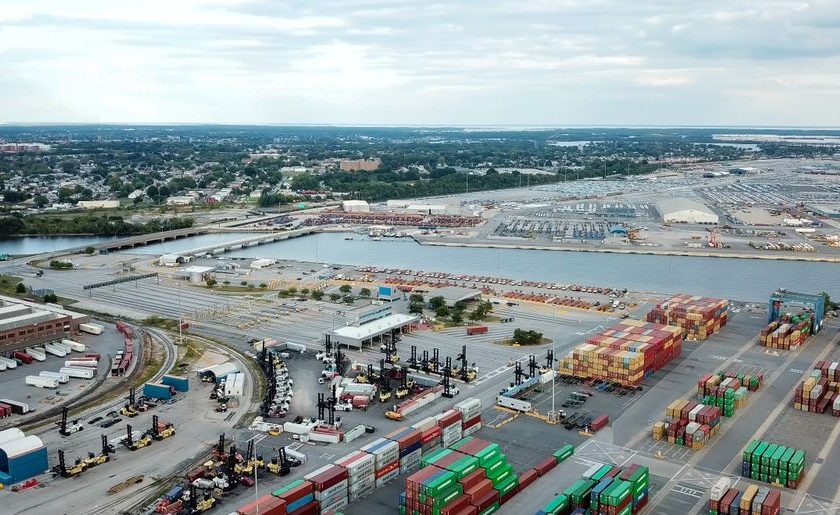1st container ship docks at Baltimore’s Seagirt Terminal since bridge collapse
NewsContainer ships have begun calling at Baltimore’s terminals, one month since the suspension of vessel traffic at the port following the Key bridge collapse.
Already, over 600 cargo loads destined for the Port of Baltimore have been redirected to neighboring ports, with Savannah leading the way with 264.

In the aftermath of the collapse of the Francis Scott Key Bridge in Baltimore, the Port of Baltimore is facing significant disruptions, impacting the flow of goods and vessels.
The tragic bridge collapse has resulted in the complete suspension of vessel traffic at the port, forcing shipping companies to reroute their cargo to nearby ports.
The Port of Baltimore is the ninth biggest port in the U.S. by trade volumes and is the number one port for imports and exports of vehicles, having handled 750,000 vehicles in 2023.
The port handled around 3% of all US East and Gulf Coast imports and 10% of US Northeast imports of containerized freight in the 12 months to Jan. 31, 2024.
It is particularly important for the wood (39% of northeast ports’ imports), construction machinery (31%) and steel/aluminum (20%) sectors, data from S&P Global Market Intelligence shows.
According to FourKites, the Dutch-based real-time supply chain visibility platform, as of March 29, 92 vessels with over 2,000 loads were either en route or had upcoming voyages into or out of the Port of Baltimore.
Of these loads, more than 1,400 are still slated for Baltimore but will now need to be rerouted due to the closure of the waterway. Already, over 600 loads have been redirected, with Savannah receiving the highest volume at 264 loads, followed by Norfolk with 181 loads, and New York with 70 loads.
Additional destinations include Port Everglades, Newark, Boston and Santos.
A great number of container shipping services that stop at Baltimore already call at bigger container ports such as the Port of New York and New Jersey, which has the capability to absorb the additional cargo.
Read also: Baltimore aftermath: Port of NY/NJ expects cargo spike, not ship increase
Port of New York and New Jersey ready to absorb additional cargo from Baltimore
Danish container shipping major Maersk has suspended bookings for Baltimore. However, the company said it was continuing to serve greater Baltimore via alternative ports such as Newark, Norfolk and Philadelphia via road and rail subject to available capacity.
“As many customers look to utilize the entire Eastern seaboard port infrastructure, we are also prepared to offer services through a number of gateways from Eastern Canada down to the South Atlantic and Gulf. Ports and rail operators have been very supportive and collaborative to develop solutions to support cargo temporarily diverted to alternative ports,” Maersk said in an update.
“We currently cannot accept any loaded containers in Baltimore, but the terminal can accept empty returns and are releasing empties for export shipments.”
Maersk’s 2M Alliance partner MSC is also rerouting vessels destined for Baltimore to the Port of New York and New Jersey, Philadelphia and Norfolk.
Furthermore, French major CMA CGM is among the many companies that have announced contingency plans for the port having declared force majeure notice.
CMA CGM determines contingency plan for Baltimore
The rerouting process, however, comes with its challenges. On average, diversions and delays are extending the estimated time of arrival by five days, impacting supply chains and logistics operations.
FourKites data highlighted the ripple effect on truckloads passing through Baltimore, leading to changed traffic patterns and potential congestion.
Commenting on the situation, Mike DeAngelis, Head of International Solutions at FourKites, emphasized the complexity of determining alternative routes.
“Determining where to reroute cargo will require the consideration of multiple factors. Many ocean steamship lines will have preferences based on the cargo they want or need to reload. The origin of the cargo also determines which carrier and service might carry the cargo and therefore influences which specific discharge ports in the U.S. will be called,” he said.
“Any containers already waiting for export from the Port of Baltimore will need to either wait for the eventual re-opening of the waterway or be gated out of the terminals and transported to one of these alternate ports. On top of that, ports taking on Baltimore’s shipments might hit capacity quickly as they see a significant spike in volume.”
Jason Eversole, VP of Professional Services at FourKites, explained the broader implications of the bridge collapse on inland moves and port alternatives. He anticipates increased pressure on other modes of transportation and ports as cargo diversions escalate, cautioning that even after debris removal, traffic in the area could be impacted, affecting trucking operations and potentially leading to price increases.
By subscribing you will have: